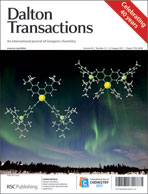The mixed metal complex [Zn(TFA)3(μ-OH)Cu3(dmae)3Br]·THF (1) and its isostructural analogues ([Zn(TFA)3(μ-OH)Cu3(dmae)3Cl]·THF (2) and [Zn(TFA)3(μ-OH)Cu3(dmae)3Cl/Br]·THF (3)) have been prepared by a simple metal ligand assembly method and were characterized by their melting points, elemental analysis, IR spectroscopy, thermogravimetry and single crystal X-ray structures. The compounds are distinguished only by the nature of the halide ions and are made up of the same [Zn(TFA)3(μ-OH)Cu3(dmae)3X]·THF molecular building block with Cu3ZnO4 cubane moieties as the central core in which the four metal ions and four oxygen atoms are joined together in alternate positions of the cuboid. All the complexes crystallize with similar packing and crystallographically related symmetry settings, distinguished mainly by the degree of disorder within the complexes and the ordering of the complexes in the structures. The triclinic cell of (1) emulates the monoclinic cell of (2) and is pseudomerohedrally twinned by a symmetry operation of the monoclinic cell. The molecules in (2) are 1 : 1 disordered around a crystallographic mirror plane. The structure of the mixed halogen compound (3) in turn is a superstructure of the less symmetric structures of (1) and (2) formed by ordering of the complexes along the longest axis of (3). Aerosol-assisted chemical vapour deposition (AACVD) experiments showed that they are promising precursors to deposit thin films of crystalline Cu/ZnO composites. The surface morphology, microstructure, chemical composition and crystallinity of the resulting Cu/ZnO composite thin films were analysed by scanning electron microscopy (SEM), X-ray diffraction (XRD) and energy dispersive X-ray analysis (EDAX), which suggest that the films are thin, crystalline, uniform, smooth and tightly adherent to the substrates with average crystallite sizes in a range between 40.2 and 80.0 nm. Particle sizes, shapes and film morphology were investigated as a function of precursor and decomposition temperature.

You have access to this article
 Please wait while we load your content...
Something went wrong. Try again?
Please wait while we load your content...
Something went wrong. Try again?


 Please wait while we load your content...
Please wait while we load your content...